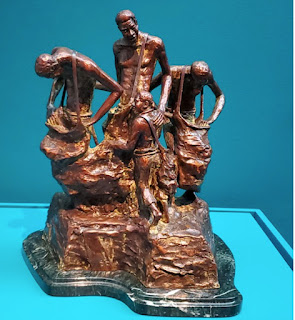Baton Rouge is uniquely where the past and the present merge and it is filled with sites that clarify and expand what you have previously learned. After French explorers came upon the Baton Rouge area in 1699 the region was thoroughly documented by Pierre Le Moyne D'Iberville's descriptions of what he called Istrouma, Red Stick, in French is Baton Rouge. He saw large red poles, adorned with animal and fish heads, placed by the Houma tribes to delineate their hunting ground. It was noted that it was desirable because it sat on the Mississippi River’s first bluff north of the Gulf of Mexico. His journal encouraged settlement, just as sofa sojourns encourage travel and a sense of adventure, and in 1718 a French fort was erected to protect travelers. @visitbatonrouge, louisianatravel.com
The Louisiana Capitol Park Museum provides an excellent overview of the history of Louisiana. It is filled with thematic galleries that are colorful, comprehensive and interactive. Highlights are the exhibits on the forms of music found in the state and, of course, those on the regional Mardi Gras celebrations. louisianastatemuseum.org/museum/capitol-park-museum
Louisiana’s Gothic Old State Capitol was completed 1850-61 on a hill. It is surrounded by an 1854 cast iron fence that fits together like a puzzle, has 4-floors and a 32-step spiral staircase. The structure’s showpiece is the rotunda’s stained-glass dome, added in 1882, comprised of 2054 panes of glass. In 1862 Louisiana seceded in the House Chamber and Long was impeached there in 1932. This National Historic Landmark opened as a museum in 1990.
The Art Deco Louisiana State Capitol is 450-ft. tall, the tallest in the US, and one of only nine without a dome. The 34-story building, on 27-acres, was completed in 1932. The front steps are inscribed with the names of the states. Elevators inside Memorial Hall are solid bronze and a statue of P. B. S. Pinchback, the country’s first African American governor, is in the lobby. Outside the Speaker’s Office was the site of the assassination of Sen. Huey P. Long in 1935 and the spot is denoted with a plaque. There is an Observation Deck on the 27th floor.
LSU Museum of Art has a collection of more than 6,000 permanent objects including a huge collection of Louisiana art. The museum has a complete menu of exhibitions and ongoing programs. lsumoa.org
Magnolia Mound Plantation occupies 16 of its original 900-acres and the 1791 Creole mansion retains its original cypress flooring. Tours of the house are augmented with the Beyond the Big House tour and features a slave domicile from the plantation on which author Ernest Gaines was born. A portion of the cabin is furnished as slave quarters and part holds displays on the enslaved. magnoliamound.org
The LSU Rural Life Museum has been designated “one of the Top 10 outdoor museums in the world”. Tours of the 42-sites are self-guided, interpret 1800s Louisiana life and are divided into four exhibit areas, The Exhibit Barn, The Working Plantation, Folk Architecture and The Gulf Coast Region. The 32-buildings, on 25-acres, are used for demonstrations and exhibits of furnishings and artifacts. An incredible highlight in the Exhibit Barn include an original relocated slave jail. rurallife.isu.edu
Houmas House Plantation and the current mansion date from the 1800s. The site interprets ante-bellum life on a sugar plantation from the viewpoint of the privileged. The 28,000-sq- ft Great River Road Museum and Interpretive Center, built at a cost of $15-million is on the grounds of Houmas House. The site includes, 2 restaurants, a café, a bar, a wine cellar, a stage, a walkway that meanders through the 36-acre gardens and a pedestrian bridge that leads to the Mississippi River. Eighteen movies have been filmed there since 1964 including Green Book. houmashouse.com
Across the Mississippi River from downtown Baton Rouge in Port Allen you’ll find the West Baton Rouge Museum, the country’s sole museum depicting sugar production from 1830s through the Civil Rights Era of the 1960s. There are 8 major historic buildings in the complex including a Slave Cabin, Reconstruction Era Cabin and Juke Joint. The interpretation is outstanding and includes actual interactive displays and authentic WPA slave narratives and inventories. A model sugar mill and the story of Norbert Rillieux and his designation as “Founder of Chemical Engineering” are highlighted in the gallery. This museum is a must! westbatonrouge.net
Southern University and Agricultural & Mechanical College, the largest historically black university, was founded in New Orleans for “colored people” in 1880. In 1890 it relocated to Scott’s Bluff on the Mississippi River north of Baton Rouge. The first building on campus was an 1840s overseer’s house remaining from its time on a plantation. It currently houses the University Archives. The Historic District includes the graves of the founding family, the Red Stick sculpture, the Wade House and the SU Museum of Art. The Red Stick Monument is situated where the original Houmas Indians marked their hunting ground. The museum consists of galleries radiating around a mid-point. Four of the galleries are dedicated to African American Art. You can view the campus, students and internationally renowned Human Jukebox Marching Band in Lizzo’s video, “Good as Hell”. It was filmed on site. subr.edu
The City has a curated 3.1-mile Heart Trail filled with trail markers and artworks. Cocha Restaurant is situated across from The Roots Wall site. The restaurant features fresh, non-GMO, seasonal, vegan and vegetarian cuisine. Enjoy a globally inspired dish as you plan your walk and soak up the art. yourhearttrail.com/baton-rouge-la, cochabr.com
The Watermark Hotel is both a destination and offers excellent accommodations from which to explore the region. Originally a bank, it is now a historic landmark hotel with 144 rooms, superb architecture and world class amenities and service. Of particular note are the 8 bas relief murals on the mezzanine, the original vault, the unique chandeliers and Mr. Bill Facey, an ambassador and historian for all things Watermark and Baton Rouge.




















































